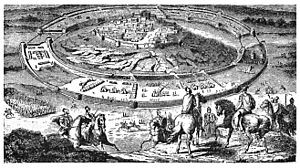Numantine War facts for kids
Quick facts for kids Numantine War |
|||||||||
|---|---|---|---|---|---|---|---|---|---|
| Part of Celtiberian Wars | |||||||||
|
|||||||||
| Belligerents | |||||||||
| Roman Republic | Arevaci, Lusones, Vaccaei, Vettones | ||||||||
| Commanders and leaders | |||||||||
| Q. Metellus Macedonicus Quintus Pompeius Marcus Popillius Laenas Gaius Hostilius Mancinus Scipio Aemilianus |
Litennon Attio Tanginus Caraunius |
||||||||
The Numantine War was a big conflict between the Romans and the Celtiberian tribes in Hispania (modern-day Spain). It was the last part of the Celtiberian Wars. This war lasted for about 20 years, from 154 BC to 133 BC.
The main fight was around the city of Numantia, which was a strong Celtiberian town. The Celtiberians were fighting because Roman leaders kept breaking peace agreements. This made the people of Numantia revolt against Roman rule.
Contents
Why the War Started
The Numantine War began because the Celtiberian tribes felt unfairly treated by the Romans. The Romans had made a peace treaty with them in 152 BC. However, Roman governors often ignored this treaty. This led to a new uprising in Numantia in 143 BC.
Early Battles and Roman Generals
The first part of the war happened at the same time as another war, the Lusitanian War. The Lusitanians were another group fighting the Romans. A Roman general named Sulpicius Galba tricked and killed many Lusitanian leaders.
- Quintus Caecilius Metellus Macedonicus: In 143 BC, Rome sent this general to Hispania. He tried to capture Numantia but failed. However, he did manage to control other tribes in the area.
- Quintus Pompeius: The next general, Quintus Pompeius, was not very good. He lost many battles against the Numantines. He secretly made a peace deal with Numantia.
- Marcus Popillius Laenas: In 138 BC, a new general arrived. When Numantine leaders came to confirm the peace, Pompeius denied ever making a deal. The Roman Senate had to decide what to do.
Broken Treaties and New Commanders
The Roman Senate decided to ignore Pompeius's peace deal. They sent Gaius Hostilius Mancinus to continue the war in 136 BC.
- Gaius Hostilius Mancinus: He attacked Numantia several times but was pushed back. His army was eventually surrounded. He was forced to agree to a new peace treaty. A young man named Tiberius Gracchus helped negotiate this treaty.
- Senate's Decision: The Senate did not approve Mancinus's treaty either. They even sent Mancinus back to the Numantines as a prisoner.
- Later Generals: The generals who came after Mancinus, Lucius Furius Philus and Gaius Calpurnius Piso, avoided fighting the Numantines directly.
The Final Siege of Numantia
In 134 BC, the Roman leader Scipio Aemilianus was sent to end the war for good. He was a very famous general.
- Scipio's Army: Scipio gathered a huge army of 20,000 Roman soldiers and 40,000 allies. This included cavalry from Numidia, led by a young prince named Jugurtha.
- Building Forts: Scipio did not attack Numantia right away. Instead, he built a ring of seven strong forts around the city. This completely cut off Numantia from the outside world.
- The Siege: This was a long and difficult siege. The Romans stopped all supplies from reaching the city. The people of Numantia fought bravely, but they eventually ran out of food and water.
- Roman Victory: Numantia finally fell to the Romans in 133 BC. This was a major victory for Rome. It brought a long period of peace to Hispania.
Important People in the War
The Numantine War was important for the careers of several famous Romans:
- Tiberius Gracchus: He was a young Roman official called a quaestor during Mancinus's failed siege. Because his father was respected by the Numantines, Tiberius was chosen to negotiate the treaty.
- Gaius Marius: He was a Roman soldier who fought in this war. He later became a very important Roman general and politician.
- Jugurtha: He was a prince from Numidia who led cavalry for Scipio. He later became an enemy of Rome himself.
Sources
- Davis, Paul K. Besieged: 100 Great Sieges from Jericho to Sarajevo. Oxford University Press, 2001.
- Wintle, Justin. The Rough Guide History of Spain. Rough Guides: Spain, 2003.
- Encyclopaedia Romana: The Celtiberian War and Numantia.
- [1]
- [2]
See also
 In Spanish: Guerra numantina para niños
In Spanish: Guerra numantina para niños


